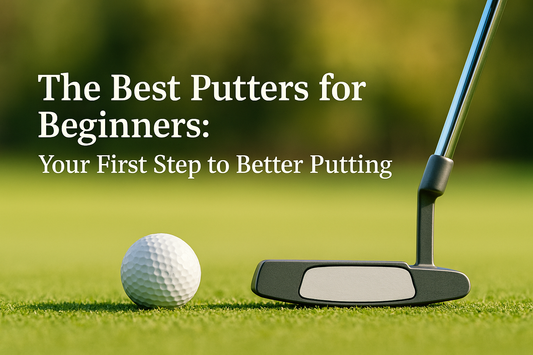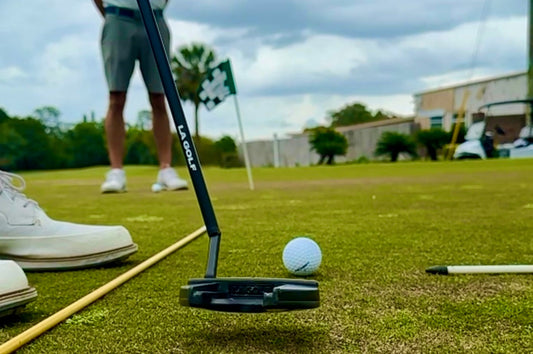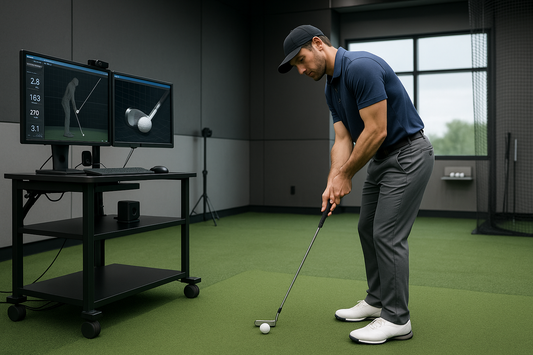After nearly three decades in the golf industry and 16 years as a PGA Professional, I've introduced thousands of beginners to the game of golf. And here's what I've learned: while there's no magic wand in golf, choosing the right putter as a beginner can dramatically accelerate your improvement and, more importantly, your enjoyment of the game.
Let me be upfront about something: the "best" putter isn't universal—it's deeply personal. But for beginners specifically, certain characteristics can make the difference between falling in love with putting or dreading every trip to the green.
Why Your First Putter Choice Sets the Foundation

Here's a statistic that might surprise you: roughly 40% of your strokes happen on the green. For a beginner shooting in the 100s or 110s, that could be 40-45 putts per round. Get the right putter in your hands early, and you'll develop good habits from day one. Choose poorly, and you might spend years fighting equipment that works against your natural tendencies.
I remember a putting lesson last summer with one of my competitive junior players when his father, a 45-year-old executive who had never touched a golf club, asked if he could try putting while his son practiced. We spent twenty minutes on the putting green with three different putters. The transformation was remarkable. With the wrong putter, he was tentative and inconsistent. With the right one, he was draining 4-footers within minutes and grinning like a kid on Christmas morning.
"I had no idea equipment could make such a difference," he told me, while his son rolled his eyes good-naturedly. Six months later, that father has become a regular player, consistently breaking 100, and putting is his strongest part of the game—much to his competitive son's amazement.
Understanding What Beginners Actually Need
Before diving into specific recommendations, let's establish what beginners typically face on the greens. Unlike high-handicappers who might have developed some bad habits, beginners are starting with a clean slate, which is actually an advantage.
The main challenges I see with new golfers include inconsistent contact with the ball, difficulty with distance control, struggles with alignment, and most importantly, lack of confidence over the ball. The good news? The right putter can address every single one of these issues.
As a beginner, you're not fighting years of muscle memory or trying to unlearn bad habits. You're building your putting foundation from scratch, which means we can set you up for long-term success right from the start.
The Mallet Advantage for New Golfers

After fitting countless beginners over the years, I almost always recommend starting with a mallet putter. Here's why: mallets are simply more forgiving, and forgiveness is exactly what beginners need most.
The larger head size of a mallet distributes weight around the perimeter, creating what we call a higher moment of inertia. In practical terms, this means when you don't hit the ball perfectly in the center of the face, which happens frequently when you're learning, the putter head won't twist as much. Your putts stay closer to your intended line even with imperfect contact.
Most mallets are also face-balanced, meaning they naturally want to stay square to your target line. This is perfect for beginners because it removes one variable from the equation. You don't have to worry about manipulating the putter face during your stroke—the design does the work for you.
I've also found that the alignment aids on most mallets give beginners a huge confidence boost. When you can clearly see where you're aiming, you're more likely to make a committed stroke. And in putting, commitment is everything.
Face Technology That Helps Beginners
When it comes to the putter face, beginners benefit most from insert technology. Unlike milled faces that provide direct feedback on every mishit, inserts offer a softer, more consistent feel that helps with distance control.
Insert faces typically use materials like urethane, aluminum, or specialized polymers that create a more uniform response across the entire face. This means even when you don't strike the ball perfectly, you'll get more predictable results.
I've noticed that beginners using insert putters develop better distance control faster than those using milled faces. The softer impact helps them feel the difference between a firm stroke and a gentle one, which is crucial for developing touch around the greens.
Getting the Basics Right: Length and Setup

One of the most overlooked aspects of putter selection for beginners is getting the correct length. I see new golfers struggling with putters that are simply wrong for their height and setup, making an already challenging game even harder.
Standard putters typically range from 33 to 35 inches, but the right length depends on your height, arm length, and preferred setup position. When properly fitted, your arms should hang naturally with your eyes positioned over or slightly inside the ball.
Here's a simple test you can do: set up to a putt in your natural position. If the putter feels like you're reaching for the ball or crowding yourself, the length is wrong. The stroke should feel effortless and natural.
The lie angle—how the putter sits on the ground—is equally important. If the toe is up in the air or digging into the ground, you're fighting the design before you even start your stroke.
Three Excellent Putters for Beginning Golfers
While I believe characteristics matter more than brand names, here are three putters that exemplify what most beginners need to succeed:
TaylorMade Spider GT Notchback
The Spider line has been helping golfers of all skill levels for years, and it's particularly effective for beginners. The high-MOI mallet design provides exceptional forgiveness on off-center hits, while the Pure Roll insert promotes consistent distance control even when you don't strike the ball perfectly.
What makes this putter especially beginner-friendly is the clear alignment system. The lines and visual cues make it easy to aim correctly, which is half the battle when you're starting out. Several of my beginning students have found immediate success with this model.
Odyssey Ai-One Square 2 Square
This newer entry into the forgiveness category is remarkably stable and forgiving. The unique weighting system helps keep the face square throughout the stroke, which is perfect for beginners who haven't yet developed consistent stroke mechanics.
The Ai-One insert technology provides excellent feel while maintaining forgiveness on mishits. During my lessons with new golfers, this putter has consistently helped students develop confidence quickly.
The Ping Fetch offers exceptional forgiveness in a clean, confidence-inspiring package. Ping has done an excellent job distributing weight around the perimeter while maintaining a look that doesn't intimidate beginners.
The combination of the stainless-steel body and aluminum sole plate creates a responsive yet soft feel that helps beginners develop touch. The built-in alignment aids are subtle but effective, helping ensure you start the ball on your intended line.
Beyond the Brand: What Really Matters for Beginners

After fitting thousands of golfers over the years, I've learned that certain characteristics matter far more than the name on the putter, especially for beginners.
Forgiveness First
As a beginner, you want maximum forgiveness. Look for putters with high MOI designs, perimeter weighting, and face-balanced characteristics. These features will help your putts stay on line even when your contact isn't perfect.
Visual Confidence
Never underestimate the importance of liking what you see when you look down at your putter. If the alignment aids make sense to your eye and the overall look gives you confidence, you're already ahead of the game.
Consistent Feel
Look for putters with insert faces or technologies that promote consistent feel across the entire face. This will help you develop distance control faster and build confidence in your stroke.
Proper Fit
Make sure the length and lie angle are appropriate for your setup. A properly fitted putter will feel natural and allow you to develop good fundamentals from the start.
The Path Forward
As a beginner, remember that putting is a skill that develops over time. Even with the perfect putter, you'll need practice and patience to improve. But starting with equipment that matches your needs and supports your development will make the journey much more enjoyable.
Don't get caught up in the marketing hype or feel like you need the most expensive option. Focus on finding a putter that gives you confidence, feels good in your hands, and has the forgiveness characteristics that will help you succeed as you learn.
The best putter for you as a beginner is one that makes you excited to practice, confident over every putt, and helps you develop good fundamentals that will serve you for years to come. Take your time, try different options, and trust your instincts. When you find the right putter, you'll know it immediately.
Remember, every great putter started as a beginner. With the right equipment and consistent practice, you'll be amazed at how quickly you can develop this crucial skill. The journey of a thousand putts begins with choosing the right flat stick—make sure yours sets you up for success from day one.





